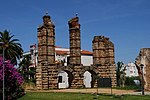Roman circus of Mérida
1st-century BC establishments in the Roman Republic20 BC establishmentsAll accuracy disputesAncient Roman buildings and structures in SpainAncient Roman circuses ... and 4 more
Buildings and structures completed in the 1st century BCBuildings and structures in Mérida, SpainHistory of ExtremaduraTourist attractions in Extremadura

The Roman circus of Mérida (Spanish: Circo romano) is a ruined Roman circus in Mérida, Spain. Used for chariot racing, it was modelled on the Circus Maximus in Rome and other circus buildings throughout the Empire. Measuring more than 400 m in length and 30 m of width, it is one of the best preserved examples of Roman circus. It could house up to 30,000 spectators.
Excerpt from the Wikipedia article Roman circus of Mérida (License: CC BY-SA 3.0, Authors, Images).Roman circus of Mérida
Calle José Ramón Mélida, Merida San Antonio
Geographical coordinates (GPS) Address Nearby Places Show on map
Geographical coordinates (GPS)
| Latitude | Longitude |
|---|---|
| N 38.916111111111 ° | E -6.3377777777778 ° |
Address
Conjunto Arqueológico de Mérida
Calle José Ramón Mélida
06800 Merida, San Antonio
Extremadura, Spain
Open on Google Maps










